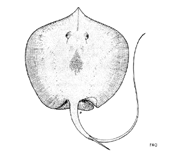Fontitrygon margarita (Günther, 1870)
Daisy stingray
Waarneming toevoegen in Fish Watcher
| Native range |

|
| This map was computer-generated and has not yet been reviewed. |
| Fontitrygon margarita AquaMaps Data sources: GBIF OBIS |
Uploaden van uw Foto's en video's
Pictures | Google afbeeldingFontitrygon margarita
Afbeelding van FAO
Pictures | Google afbeeldingFontitrygon margarita
Afbeelding van FAO
Classificatie / Names Lokale namen | Synoniemen | Catalog of Fishes(Genus, Soort(en)) | ITIS | CoL | WoRMS | Cloffa
Elasmobranchii (haaien en roggen) (sharks and rays) > Myliobatiformes (Stingrays) > Dasyatidae (Stingrays) > Urogymninae
Eponymy: These are not eponyms but relate to the meanings of ‘margarita’; pearl and daisy. The dragonfish was so-named due to having a “pearl-colored spot above the maxilla”. (Ref. 128868), visit book page.
More on author: Günther.
Eponymy: These are not eponyms but relate to the meanings of ‘margarita’; pearl and daisy. The dragonfish was so-named due to having a “pearl-colored spot above the maxilla”. (Ref. 128868), visit book page.
More on author: Günther.
Issue
Distribution will be corrected.
Environment: milieu / climate zone / depth range / distribution range Ecologie
marien; brak water demersaal; diepte 1 - 60 m (Ref. 4438). Tropical; 21°N - 17°S
Verspreiding Landen | FAO regio's | Ecosystemen | Voorkomen | Point map | Introducties | Faunafri
Eastern Central Atlantic: Senegal to Congo (Ref. 114953).
Grootte / Gewicht / Leeftijd
Maturity: Lm ? range ? - ? cm
Max length : 100.0 cm WD mannelijk / geslacht onbekend; (Ref. 3170); common length : 60.0 cm WD mannelijk / geslacht onbekend; (Ref. 26999); max. gepubliceerd gewicht: 20.0 kg (Ref. 81259)
Max length : 100.0 cm WD mannelijk / geslacht onbekend; (Ref. 3170); common length : 60.0 cm WD mannelijk / geslacht onbekend; (Ref. 26999); max. gepubliceerd gewicht: 20.0 kg (Ref. 81259)
Korte beschrijving Determinatiesleutels | Morfologie | Morfometrie
Wervels: 130. Diagnosis: A large Dasyatis species most closely related to the much smaller Dasyatis margaritella and to the extremely flat D. garouaensis (Ref. 26277). Pearl spines always present and very large; denticles on dorsal surface of disc smooth, restricted to middle portion (Ref. 26277).
Body shape (shape guide): other; Cross section: flattened.
Body shape (shape guide): other; Cross section: flattened.
Dasyatis margarita is a coastal marine species, entering lagoons, shallow bays and estuaries (Ref. 3497, 81259). Feeds on shrimps, crabs, bivalves and annelids (Ref. 28587). Ovoviviparous (Ref. 50449).
Levenscyclus en paargedrag Maturiteit | Voortplanting | Paaien | Eieren | Fecunditeit | Larven
Exhibit ovoviparity (aplacental viviparity), with embryos feeding initially on yolk, then receiving additional nourishment from the mother by indirect absorption of uterine fluid enriched with mucus, fat or protein through specialised structures (Ref. 50449). Distinct pairing with embrace (Ref. 205).
Hoofdreferentie
Upload your references | Referenties | Coördinator : McEachran, John | Medewerkers
Capapé, C. and M. Desoutter, 1990. Dasyatidae. p. 59-63. In J.C. Quero, J.C. Hureau, C. Karrer, A. Post and L. Saldanha (eds.) Check-list of the fishes of the eastern tropical Atlantic (CLOFETA). JNICT, Lisbon; SEI, Paris; and UNESCO, Paris. Vol. 1. (Ref. 4438)
Status op de Rode Lijst van het IUCN (Ref. 130435: Version 2024-2)
Kwetsbaar (VU) (A2d); Date assessed: 04 August 2020
CITES
Not Evaluated
Gevaar voor de mens
Harmless
Gebruik door de mens
Visserij: commercieel
FAO - Publication: search | FishSource |
Meer informatie
Population dynamics
Groeiparameters
Max. ages / sizes
Length-weight rel.
Length-length rel.
Lengtefrequenties
Massaconversie
Rekrutering
Abundantie
Groeiparameters
Max. ages / sizes
Length-weight rel.
Length-length rel.
Lengtefrequenties
Massaconversie
Rekrutering
Abundantie
Life cycle
Voortplanting
Maturiteit
Maturity/Gills rel.
Fecunditeit
Paaien
Spawning aggregations
Eieren
Ontwikkeling van de eieren
Larven
Larvale populatiedynamiek
Voortplanting
Maturiteit
Maturity/Gills rel.
Fecunditeit
Paaien
Spawning aggregations
Eieren
Ontwikkeling van de eieren
Larven
Larvale populatiedynamiek
Anatomy
Kieuwoppervlak
Brain
Otolith
Kieuwoppervlak
Brain
Otolith
Physiology
Body composition
Nutrients
Zuurstofverbruik
Zwemtype
Zwemsnelheid
Visual pigments
Fish sound
Diseases & Parasites
Toxicity (LC50s)
Body composition
Nutrients
Zuurstofverbruik
Zwemtype
Zwemsnelheid
Visual pigments
Fish sound
Diseases & Parasites
Toxicity (LC50s)
Genetics
Genetica
Heterozygosity
Erfelijkheid
Genetica
Heterozygosity
Erfelijkheid
Human related
Aquaculture systems
Aquacultuurprofielen
Kweeklijnen
Ciguatera cases
Stamps, coins, misc.
Aquaculture systems
Aquacultuurprofielen
Kweeklijnen
Ciguatera cases
Stamps, coins, misc.
Tools
E-boek | Veldgids | Determinatiesleutels | Lengtefrequentie Tool | Levenscyclus tool | Verspreidingskaart | Classification Tree
| Catch-MSY |
Speciale rapporten
Bekijk gegevens voor het houden in een aquarium | Bekijk Fact Sheets voor de soort | Bekijk Aquacultuur Fact Sheets
Download XML
Internetbronnen
AFORO (otoliths) | Aquatic Commons | BHL | Cloffa | BOLDSystems | Websites from users | Bekijk FishWatcher | CISTI | Catalog of Fishes: Genus, Soort(en) | DiscoverLife | ECOTOX | FAO - Publication: search | Faunafri | Fishipedia | Fishtrace | GenBank: genoom, nucleotide | GloBI | Google Books | Google Scholar | Google | IGFA World Record | MitoFish | Nationale databanken | Otolith Atlas of Taiwan Fishes | PubMed | Reef Life Survey | Socotra Atlas | Tree of Life | Wikipedia: ga naar, zoek | World Records Freshwater Fishing | Zoological Record
Estimates based on models
Preferred temperature (Ref. 123201): 23 - 28, mean 26.5 °C (based on 76 cells).
Fylogenetische diversiteitsindex (Ref. 82804): PD50 = 0.5156 [Uniqueness, from 0.5 = low to 2.0 = high].
Bayesian length-weight: a=0.01023 (0.00486 - 0.02155), b=3.06 (2.87 - 3.25), in cm total length, based on LWR estimates for this (Sub)family-body shape (Ref. 93245).
Trofisch niveau (Ref. 69278): 3.4 ±0.50 se; based on food items.
Weerstandsvermogen (Ref. 120179): laag, minimale populatieverdubbelingstijd 4,5-14 jaar (Assuming fecundity<100).
Fishing Vulnerability (Ref. 59153): Very high vulnerability (90 of 100).
Nutrients (Ref. 124155): Calcium = 34.7 [8.3, 159.9] mg/100g; Iron = 0.765 [0.192, 2.007] mg/100g; Protein = 21.9 [19.0, 24.9] %; Omega3 = 0.174 [0.049, 0.512] g/100g; Selenium = 41.1 [11.0, 113.3] μg/100g; VitaminA = 13.3 [5.9, 29.3] μg/100g; Zinc = 1.1 [0.5, 2.0] mg/100g (wet weight);




